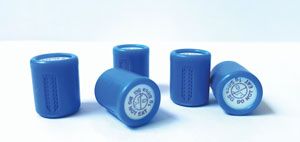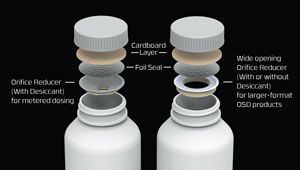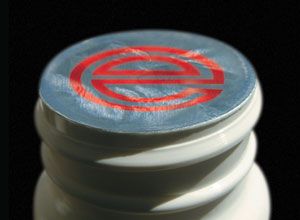Protecting Solid-Dose Shelf Life
Barrier materials, scavengers, and good seal integrity maximize shelf-life of oral solid-dosage drug packaging.
MONROPIC/STOCK.ADOBE.COM

Tactics to protect or extend the shelf life of solid dosage forms fall into two main categories: passive barrier materials and active packaging. The former prevents transmission of shelf life-sapping influences such as oxygen and water vapor. The latter actively scavenges, or captures, deleterious substances. Seal integrity plays a role as well. Weak spots can occur in the packaging wall, in the sealing surfaces between containers and closures, or in the sealed seams of blister packs.
Changes in solid-dose products, the advent of new drug delivery systems, and the increase in generic-drug manufacturing are spurring interest in active and passive shelf life-protecting technologies. “Branded drugs continue to be released with more complex characteristics to facilitate solubility and bioavailability, including timed release, delayed release, quick release, or combinations that inherently impact hygroscopicity and stability,” reports Mark Florez, product manager, Business Development & Marketing at Clariant North America.
Oliver Stauffer, chief executive officer at PTI Packaging Technologies and Inspection, a supplier of seal integrity testing equipment, agrees, noting: “More complex formulations, delivering hormones, for example, are potentially more susceptible to oxidation and other influences and more at risk.”
There’s also a need for longer shelf life. Stuart Brown, business development manager at Sanner Group, a pharmaceutical packaging specialist, explains, “The shelf life of solid-dosage forms was usually set to about two years. We are currently witnessing the growing demand of many pharmaceutical companies to extend it to a minimum of three years, preferably even longer. Accordingly, requirements are also changing regarding packaging.”
As a result, demand is rising not only for improved barrier materials, but also in more powerful desiccants for moisture protection and scavengers for gases, such as oxygen, carbon dioxide, and ethanol. “[Scavengers for] volatile organic compounds, such as formaldehyde, are also of growing interest,” says Craig Voellmicke, vice-president of Business Development for CSP Technologies, a supplier of active packaging technologies.
Considerations for shelf life-protecting packaging
Better barrier
Barrier properties can be boosted by material choice, thickness, and structure (i.e., coating or multiple layers). An alternative to high-barrier materials, such as polychlorotrifluoroethylene (PCTFE) and cold-formed foil, the Flexapharm SBC240 polyvinyl chloride/polyethylene lamination from Tekni-Plex provides a substantial barrier to water vapor and oxygen by applying a 240 g/m2coating weight of a polyvinylidene chloride variant. Coating weights can be customized, but multiple standard grades (120-, 150-, 180- , 210-, and 240-g/m2 coating weights) cover a multitude of barrier needs. “This technology offers a great degree of customization and flexibility compared to alternative laminated structures,” says Melissa Green, senior director Global Marketing & Strategy, Tekni-Films, a Tekni-Plex business.
She adds, “To date, Flexapharm SBC240 has the best oxygen barrier of any thermoformable blister material available in the market, while also providing the same moisture barrier as a 6-mil [-thick] PCTFE. Another added benefit of all SBC structures is that oxygen barrier performance does not vary with changes in relative humidity. The combination of moisture and oxygen barrier properties makes it uniquely suited to protect drugs for companies wishing to maximize their shelf life in a thermoformed blister, instead of packaging in blister packs that would be double in size if packaged in a cold-formed foil blister. In addition, the clarity of the SBC240 gives patients insight into whether … they’ve taken their prescribed dose, improving the compliance to the drug therapy.”
The SBC240 coated lamination can represent a materials savings throughout the packaging process. It doesn’t need stiffening ribs, which are sometimes necessary to ensure PCTFE blisters lie flat, and it is formable into smaller blister wells than cold-formed foil. So, a smaller blister card can be specified, or the number of doses per card can be increased. The lamination also favorably impacts production efficiency because it offers a wider processing window than PCTFE-as much as 20 oF.
Active packaging
Options for desiccants, oxygen absorbers, and other scavenging technologies continue to expand. Sachets, canisters, and capsules are becoming smaller and more powerful, but increasingly, the scavenger is integrated into packaging materials.
Figure 1. Sanner Group AdCap capsules can be customized in blue instead of the usual white to differentiate the desiccant capsule from product. A grid structure in the capsule wall enhances moisture adsorption. Courtesy Sanner Group.

One new product, Clariant’s EQius humidity stabilizer, maintains a specific relative humidity (RH) inside a drug package. It can be calibrated to different RH levels (e.g., to maintain a drug product within a 20% RH range throughout its shelf life). Equilibrium levels range from 10–30% RH, and the technology is available in capsule, canister, packet, stopper, and bag forms. Although standard desiccants maintain dry conditions inside the package, there’s a possibility of the package environment becoming over dry, which can be detrimental. “Gelatin capsules can have critical stability attributes at both high and low humidity thresholds,” explains Florez. “Excessively high humidity can cause API degradation, while overly dry conditions can cause brittleness and friability of the gelatin capsule.”
Sanner Group has expanded its AdCap capsules portfolio. One, filled with activated carbon, ensures optimum odor adsorption. The other holds a mixture of silica gel and activated carbon for both odor and moisture adsorption. Capsules generally handle faster on filling machines due to their shape and fineness, and properties can be customized.
Figure 2. An orifice-reducing element of CSP Technologies Activ-Seal closure is affixed on the top of the bottle during the induction sealing process. It is covered by a lift-and-peel foil seal which, once removed, enables metered dosing. The scavenging component is permanently positioned on the underside of the orifice reducer. Courtesy CSP Technologies.

A grid structure enables 360-degree moisture adsorption (see Figure 1). Brown explains, “The unique grid structure in the capsule wall combines the advantages of conventional capsules and canisters. Even if the capsule ends up on the cardboard side within the container after filling, moisture adsorption is ensured without losing effectiveness. This leads to up to 30% higher moisture adsorption compared to conventional capsules and, consequently, prolongs the shelf life of pharmaceuticals. In addition, the tactile grid structure prevents confusion with drugs, and thus accidental ingestion, ensuring higher patient safety.”
Another tactic to overcome issues with accidental ingestion is integration of the desiccant/scavenger into the packaging. An integrated system also eliminates the need for dispensing equipment and the related step on the packaging line, as well the chance for premature removal by the consumer.
Activ-Seal tamper-evident screw closures from CSP Technologies permanently integrate a molded desiccant or scavenger into the bottle neck. The desiccant/scavenger component is press-fit into the cap, which also contains an induction seal (see Figure 2). The technology is compatible with standard bottles and capping systems and requires no changes to packaging lines.
Seal integrity
Another shelf life-sustaining option for bottles, induction sealing, prevents oxygen and moisture from entering the container through its mouth (see Figure 3). Mark Plantier, vice-president of Marketing at Enercon Industries, a supplier of induction-sealing equipment, notes: “An unsealed container opening is the biggest threat to product freshness … [the induction seal] helps preserve product integrity while extending shelf life. Additionally, a desiccant can be used to absorb moisture trapped in the headspace or that may transgress through the walls of the container.”
Figure 3. An induction seal prevents oxygen and moisture from entering a container through its mouth. Courtesy Enercon Industries.

The cap, induction foil, and container quality all influence seal integrity. “The interaction between the cap and container threads is very important,” says Plantier. “A properly torqued cap provides the pressure required for induction sealing. Additionally, a consistent land area on the mouth of the container is required for successful sealing.”
The choice of sealing head also impacts seal integrity. Plantier reports: “Enercon offers application-specific sealing heads depending on line speeds and cap size and style. For example, with most child-resistant caps, the induction foil is seated well below the cap, and a tunnel sealing head is more efficient.”
To maximize seal quality, Enercon has developed a cap inspection system that detects high caps, missing foils, and stalled bottles. Today’s induction cap sealers are easier to integrate and operate and can be washdown-compatible. Typical features and options include automated reject, quick-connect systems, infeed bottle stop, password-protected supervisory settings, diagnostic help screens, uploadable event logs, recipe menus, intuitive setup screens, and multiple language support.
Because seal defects can allow ingress of oxygen, water vapor, and other undesirable influences, quality control plays an important role in ensuring seal integrity. Today’s vacuum-based leak testers can detect leaks in the single-digit micron range on blisters or induction-sealed bottles.
For blister packages, PTI offers the VeriPac UBV leak tester. It combines an image processing system and sequence of vacuum cycles to test blister cards and identify defects. The operator simply places the card in the unit; no card-specific tooling is needed. The non-destructive test means no loss of product unless a flaw is detected, and even then, it may be possible to perform a deeper investigation. The UBV tester replaces the traditional blue dye test, which is a destructive test that relies on subjective observations and can be time-consuming and error-prone. “With the blue dye test, every cavity needs to be inspected, and it’s possible to overlook a defect as large as a thumbtack hole,” says Stauffer. “The products with the greatest level of risk are packaged in cold-form blister packs, which require each cavity to be individually opened and carefully inspected. Even if the pack is flawless, the test destroys it. This not only means loss of product, but higher disposal costs because the packs must be disposed of in a controlled manner.”
For rigid containers and pouches, PTI’s VeriPac 465 vacuum leak tester uses patent-pending hardware and sequencing of pneumatics to provide better control and measure vacuum decay. “By focusing on inert gas laws and the physics of what happens in the test chamber, the Veripac 456 vacuum leak tester results in more stable measurement and detection of smaller leaks. The flexible system can be paired with various test chambers to allow testing of pouches as well as rigid containers,” says Stauffer.
What’s next?
In the coming decade, the growth of new delivery systems, such as quick-dissolve tablets or strips and sublingual dosage forms, will impact protective packaging. Active packaging technologies will be needed to protect drug products exposed to varied storage conditions and climates, particularly Zone III and Zone IV. “The ability to manage headspace at time of packaging as well as ingress/egress over time are key,” says Voellmicke.
Demands for even longer shelf life will continue to grow. Brown predicts, “We will see even higher requirements in the area of barrier properties … This will necessarily also increase the requirements concerning material properties, above all in plastic packaging.”
Green agrees: “We see potential for active barrier or ‘smart’ materials that indicate expiration or that the drug has been exposed to unhealthy heat and humidity. However, the industry is somewhat risk-averse and doesn’t always adopt new innovations quickly. The real opportunity for shelf-life extension/protection may really be simply utilizing the current packaging platforms to the fullest, such as fully embracing the blister versus the bottle. Unit-dose packaging, where a single dose is encapsulated in its own ‘dome of protection’ may really be the best way to ensure our solid dosage forms are protected adequately until consumed by the patient. The opening and closing of a bottle continuously exposes the remaining doses to moisture and oxygen. This may not offer enough protection to ensure that the first dose is as efficacious as the last in the bottle.”
Stauffer predicts product chemistry will impact the importance of packaging in protecting and extending shelf life. He says, “New chemistries may be less susceptible to oxidation.” He believes some injectable treatments will be converted to oral doses. “With parenteral products, there’s always the risk of microbial ingress, especially in humid climates,” he explains.
Florez also says conversions from biopharma injectable to solid dosage forms will occur. “This is challenging due to the nature of biopharmaceuticals, but once accomplished would impact the protective packaging space,” he concludes.
Article Details
Pharmaceutical Technology
Vol. 42, No. 10
October 2018
Pages: 52–54, 57
Citation
When referring to this article, please cite it as H. Forcinio, "Protecting Solid-Dose Shelf Life," Pharmaceutical Technology 42 (10) 2018.
About the Author
Hallie Forcinio is Pharmaceutical Technology’s Packaging editor, editorhal@cs.com.

Pharmaceutical Tariffs Are Imminent: How Industry is Bracing for Impact
April 16th 2025On April 14, 2025, the Trump Administration launched a national security-driven investigation into pharmaceuticals, a move that will likely result in tariffs being placed on pharmaceutical drugs, ingredients, and other components that are imported from outside of the United States.
Drug Solutions Podcast: A Closer Look at mRNA in Oncology and Vaccines
April 30th 2024In this episode fo the Drug Solutions Podcast, etherna’s vice-president of Technology and Innovation, Stefaan De Koker, discusses the merits and challenges of using mRNA as the foundation for therapeutics in oncology as well as for vaccines.